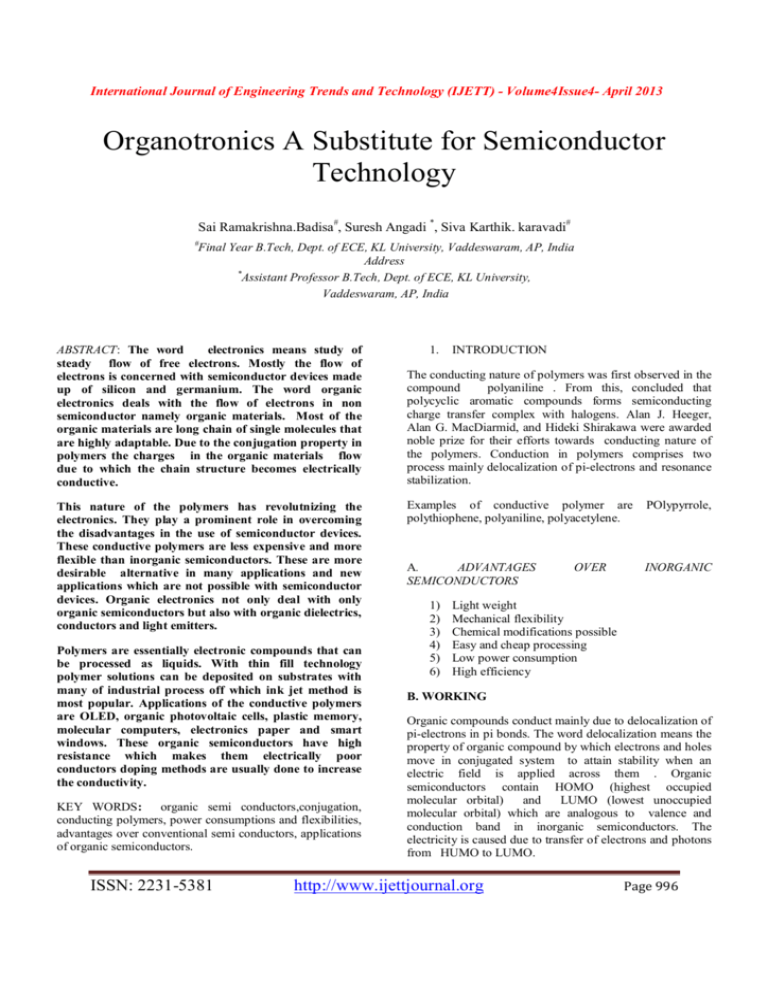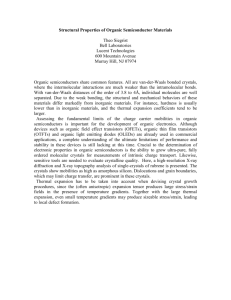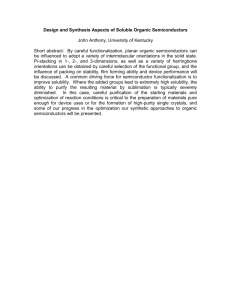Organotronics A Substitute for Semiconductor Technology
advertisement

International Journal of Engineering Trends and Technology (IJETT) - Volume4Issue4- April 2013 Organotronics A Substitute for Semiconductor Technology Sai Ramakrishna.Badisa#, Suresh Angadi *, Siva Karthik. karavadi# # Final Year B.Tech, Dept. of ECE, KL University, Vaddeswaram, AP, India Address * Assistant Professor B.Tech, Dept. of ECE, KL University, Vaddeswaram, AP, India ABSTRACT: The word electronics means study of steady flow of free electrons. Mostly the flow of electrons is concerned with semiconductor devices made up of silicon and germanium. The word organic electronics deals with the flow of electrons in non semiconductor namely organic materials. Most of the organic materials are long chain of single molecules that are highly adaptable. Due to the conjugation property in polymers the charges in the organic materials flow due to which the chain structure becomes electrically conductive. This nature of the polymers has revolutnizing the electronics. They play a prominent role in overcoming the disadvantages in the use of semiconductor devices. These conductive polymers are less expensive and more flexible than inorganic semiconductors. These are more desirable alternative in many applications and new applications which are not possible with semiconductor devices. Organic electronics not only deal with only organic semiconductors but also with organic dielectrics, conductors and light emitters. Polymers are essentially electronic compounds that can be processed as liquids. With thin fill technology polymer solutions can be deposited on substrates with many of industrial process off which ink jet method is most popular. Applications of the conductive polymers are OLED, organic photovoltaic cells, plastic memory, molecular computers, electronics paper and smart windows. These organic semiconductors have high resistance which makes them electrically poor conductors doping methods are usually done to increase the conductivity. KEY WORDS: organic semi conductors,conjugation, conducting polymers, power consumptions and flexibilities, advantages over conventional semi conductors, applications of organic semiconductors. ISSN: 2231-5381 1. INTRODUCTION The conducting nature of polymers was first observed in the compound polyaniline . From this, concluded that polycyclic aromatic compounds forms semiconducting charge transfer complex with halogens. Alan J. Heeger, Alan G. MacDiarmid, and Hideki Shirakawa were awarded noble prize for their efforts towards conducting nature of the polymers. Conduction in polymers comprises two process mainly delocalization of pi-electrons and resonance stabilization. Examples of conductive polymer are polythiophene, polyaniline, polyacetylene. POlypyrrole, A. ADVANTAGES SEMICONDUCTORS INORGANIC 1) 2) 3) 4) 5) 6) OVER Light weight Mechanical flexibility Chemical modifications possible Easy and cheap processing Low power consumption High efficiency B. WORKING Organic compounds conduct mainly due to delocalization of pi-electrons in pi bonds. The word delocalization means the property of organic compound by which electrons and holes move in conjugated system to attain stability when an electric field is applied across them . Organic semiconductors contain HOMO (highest occupied molecular orbital) and LUMO (lowest unoccupied molecular orbital) which are analogous to valence and conduction band in inorganic semiconductors. The electricity is caused due to transfer of electrons and photons from HUMO to LUMO. http://www.ijettjournal.org Page 996 International Journal of Engineering Trends and Technology (IJETT) - Volume4Issue4- April 2013 C. IMPLANTATION OF ORGANIC COMPOUNDS In general the organic compounds have to be implanted on substrates for their purpose to work as a support. There are many methods to implant organic compounds on substrates and they are 1. 2. 3. Ink jet printing Organic vapor phase deposition(OVPD) Vacuum thermal evaporation(VTE) Among the above three , ink jet method is very cheap and most commonly used technique. This method is same as paper printing mechanism where the organic layers are sprayed onto the substrates. Organic vapor phase deposition (OVPD) is of low cost. In this method a cooled substrate is being hit by the organic molecules are evaporated in a low pressure, high temperature chamber. This gas is carried onto the substrate with the help of a carrier gas. In vacuum thermal deposition (VTD) method organic molecules are gently heated so that they evaporate and subside on substrate. II. ORGANIC LIGHT EMITTING DIODES OLEDs are simple solid state devices that work on the principle of ELECTRO-LUMINESCENCE. They comprise very thin films of organic compounds in the electroluminescent layer. These organic compounds are to be designed in between electrodes. One among the electrodes must be transparent and the resultant is a very bright and crispy display with less power consumption than usual LCD and LED. A. STRUCTURE An OLED mainly consists of following parts 1) Substrate 2) Electrodes 3) Organic layers Substrate is the material on which the organic compounds are implanted. Commonly used may be plastic, foil or even glass. Fig 1.1 structure of OLED Electrodes comprise cathode and anode. Cathode must have great work function which helps in injecting holes into different layers and usually used is indium tin oxide(ITO). The cathode component must have lesser work function than anodes which help in injecting electrons into different layers. Emissive layer is made up of polyfluorene . Conductive layer is usually made up of polyaniline. B. TYPES OF OLED There are many types of OLED each have many advantages in present day life. They are 1) Passive matrix , 2) Active matrix , 3) Inverted , 4) Foldable , 5) Top emitting , 6) Transparent , 7) Stacked OLED. C. ADVANTAGES OVER LED AND LCD 1) Like LCD , the OLED doesn’t require a backlight for its normal working. This makes them more advantageous in saving space and also weight. 2) OLED is also capable of making high contrast ration in dark regions. Thickness of OLED is 200 times smaller than LED. 3) Refresh time of OLED is far less than LED and LCD. 4) They can be used in fabrication of clothes, manufacturing is highly commercial and economical. D. DISADVANTAGES 1) The life time of OLED is very less , 2) The colour of the display by time, 3) These are not water resistant. ISSN: 2231-5381 http://www.ijettjournal.org Page 997 International Journal of Engineering Trends and Technology (IJETT) - Volume4Issue4- April 2013 Applications : Oled’s are used as mobile phone screens,MP3players,digital cameras, car radios, PDA’s and so on . crystalinity of the organic material we can achieve higher mobility. V. DRAWBACKS OF ORGANIC SEMICONDUCTORS POOR CRYSTALINITY: III. ORGANIC PHOTO VOLTAIC CELL With increase of human needs there arose a need of lot many resources that are becoming scarce, that satisfy human wants. Shifting from non conventional energy sources to renewable energy sources is the only option to escape from above crisis. Organic photo voltaic cells have became one among the best one two utilize aforesaid renewable energy source in an efficient way. Instead of semiconductor layer in between the two electrodes two organic layers made of different materials are placed in OVPC. Cells using single organic layer gives low mobility. Poor crystalinity is the main drawback of organic compounds that has its impacts on many other properties like mobility. LOW MOBILITY: 1) Weak inter-molecular coupling 2) Amorphous nature of organic compounds cause thermally activated hopping transport, no band transport 3) Poly-crystalline of the material causes scattering at grain boundaries DEGRADATION: 1) Organic compounds can be easily degraded with environmental influences. 2) These materials are not water resistant Above two factors with combination of others may cause life time of the organic semiconductors to be less. VI. CONCLUSION A. WORKING Working of OPVC occurs in 4 stages they are mainly 1) Formation of Exciton 2) Diffusion of Exciton to organic-organic interface 3) Dissociation of exciton 4) Collection of charge carriers at electrodes Organic solar cells produce a significant amount of electricity in diffused light. Life span of these OPVC is less when compared with that of conventional solar cells. IV. ORGANIC THIN FILM TRANSISTORS They differ from ordinary FET in the channel. In FET channel is made up of metal oxide compound. In OTFT channel is made up of organic material. This differs from the conventional transistor where the semiconductor material typically is the substrate. Formation of positive charge accumulation semiconductor-insulator interface upon application positive voltage at GATE. Even though gate voltage is applied low conductivity is seen. With increase ISSN: 2231-5381 Organic semiconductor technology is the latest technology that replaces semiconductor technology in many areas. Organic semiconductors offer a low cost alternative to established semiconductors when it comes to large area and low cost applications. First OLED applications are already on the market. OTFTs and OPVCs will most probably follow. Improvements on the material side are still needed. REFERENCES [1] http://en.wikipedia.org/wiki/Organic_electronics [2] http://www.orgworld.de/ [3] http://www.organicsemiconductors.com/ [4] http://www.newelectronics.co.uk/electronicstechnology/ [5] http://en.wikipedia.org/wiki/Conductive_polymer [6] http://www.sciencedirect.com/science/article [7] Book on Organic Electronics Series: Advances in Polymer Science, Vol. 223Meller, Gregor; Grasser, Tibor (Eds.) 2010, XIV, 330 p. [8] http://www.wmich.edu/ at of not in http://www.ijettjournal.org Page 998 International Journal of Engineering Trends and Technology (IJETT) - Volume4Issue4- April 2013 BIOGRAPHY Badisa Sai Ram Krishna was born in 1992 in Krishna District. He is currently pursing B.Tech from K L University. He is interested in Telecommunications and electronics. Email: ramkrishna.341@gmail.com Suresh Angadi* is presently working as a Asst.Professor in K L University. He received his B.Tech degree in electronics and communication in G.V.P College of Engineering, vizag, 2007 and completed M.Tech in Maulana Azad National Institute of Technology in 2009, Bhopal. Karavadi Siva Karthik# was born in 1991 in Krishna District. He is currently pursing B.Tech Electronics degree from K L University. He is interested in electronics and Tele- Communication. Email:karthik.karavadi@live.in ISSN: 2231-5381 http://www.ijettjournal.org Page 999






